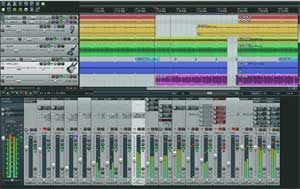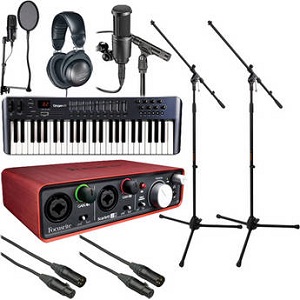
Audiofanzine just listed the top 18 digital audio workstations (DAWs), otherwise known by the names audio/MIDI sequencers, multi-track recording software, etc. This is always an interesting thing. Not only do people love “top” lists, but I like to see whether the software I use s my primary DAW, Reaper, is on the list. It is:). Why wouldn’t it be?
But it’s also cool to check out what else is on the list. Who knows? You may see something you’ve not heard of before and want to try it.
I don’t know why they chose 18 as their “top” number. Why not top 10? My guess is that there are too many good programs out there that are just as good as many of the others.
One note about their list is that they focused only on music production programs, as opposed to the more expensive broadcast-focused ones like Nuendo (1,700 bucks), Sequoia (2, 980 bucks), and Pyramix (2,962 bucks).
Reaper is number 11 on their list, interestingly right after Pro Tools at number 10. I say that’s interesting because Pro Tools is widely regarded to be the industry standard. But lists like this are subjective for sure. They (Audiofanzine) even admit this right up front. Maybe that’s why they chose Sony Acid as number 1. I’m thinking it’s possible the list may not even be in rank order. Maybe they just randomly through up the top 18 in any order.
Anyway, here is the page with the list and descriptions of each program: http://en.audiofanzine.com/plugin-sequencer/editorial/articles/the-best-daws.html
As I said, sequencers/DAWs are pretty personal. But it may be worth trying a few to see which ones you like best.
Home Recording Equipment
Transformers And Why They Are Used In Audio Gear
I just read a very informative, if somewhat technical, article about transformers and why they are used in audio hardware.
If you are not an electrician, or don’t have a background in electrical engineering of any shape or size, you may not know what a transformer even is. If I’m being honest, I have to think about it myself sometimes. And I had both digital and analog electrical engineering courses in college – though I now desperately which I had paid better attention at the time:-P. In my defense, the material never spoke to my needs, which at the time had to do with my band’s PA system and our issues with feedback, etc.
Anyway, I digress as usual. In the most basic description, a transformer transforms things. Duh. But we’re not talking about cars-into-robots here. It’s about electrons. Those pesky electrons and how they flow (another simplistic explanation of electricity in general).
A transformer separates two electrical things physically. For example, instead of a single wire connecting two things – say a switch and a light bulb, you can stick a transformer in the middle of the wire. A transformer has two coils of wire inside it. If you had paid attention in your physics or EE class, you may have had a lesson in “induction.” This means that an electrical current can be passed between two things without them even touching. Often this is demonstrated with magnets or even rubbing a rabbit fur on a plastic rod and then holding it over your head to watch it suck your hair to through the ether. This is a form of induction. One thing (a magnet or a charged rod) “induces” the current in something else (metal shavings, hair, etc.).
But why is that useful? Well, if you have some unwanted thing traveling along the first electrical portion, like a hum or something, you don’t want to pass the hum along to the destination. So you can “de-couple” (a fancy way of saying “physically separate”) the signals. But then how do you keep the desired power flowing? The answer is induction. The first coil of wire (remember the two coils thing in a transformer?), which is physically separated from the second coil, induces the signal to the second coil. This “air gap” (my term for understanding it) drops the unwanted stuff and only passes the wanted stuff along the circuit.
Now before the experts start hurling criticisms – yes, this does only describe one use of a transformer. You can use them for other things like transforming one type of electricity to another, useful for taking your hair dryer to Europe from the US. We lived in England for 4 years and had to have these heavy transformer boxes all over the house so we could plug in our American appliances.
Anyway, here is that article that speaks to how and why we need or want them in our audio gear. http://www.prosoundweb.com/article/making_it_match_an_introduction_to_transformers_in_audio_devices/
You Don't Need To Spend 860 Bucks On A Starter Studio

I just saw a video over on CNET that described setting up a home music recording studio for under $1,000. And that was supposed to make you think it was a great price. Holy cow! You can do much better.
The CNET studio items are excellent. There is no doubt of that. But if you are not ready to drop $860 dollars for a starter studio, check out the same basic setup that B&H Pro Audio put together with my specs, and that will cost you only $399.99 – The Musicians Home Recording Starter Kit.
One thing that is important to note here is that the CNET package did not include mic stands, and it only included one mic – the large diaphragm condenser (Rode NT1-A). Our package has 2 mic stands, a large diaphragm Audio Technica AT-2020) AND a small diaphragm condenser mic (the latter being excellent for acoustic guitar and as a shotgun mic replacement on video shoots).
Yes, the Rode NT1-A is a very good mic. And so are a lot of mics over $200. But you know what? There are some excellent mics under $200 as well. The Rode is not necessarily the best choice for your first studio. Once you know that audio recording is going to feature prominently in your life or business, upgrade to the more expensive mics one at a time.
Oh, and you also get Pro Tools SE along with our package as well, just like the CNET recommendations.
So if you want a musicians starter studio that can record pro quality audio, you can get that for $496.95 from B&H, or build your own according to the CNET video for $896. Your choice:).
Check out the CNET recommendation here: http://cnettv.cnet.com/build-your-own-mobile-recording-studio-under-1/9742-1_53-50146360.html
Happy recording.
Ken
Video Tutorial – FL Studio Appegiator
There used to be a nice simple 4-channel digital drum machine program, released in 1998, called Fruity Loops. It allowed you to create sequenced drum and rhythm patterns, doing cool things like matching tempos of drum loops that you imported to the program. Well, a lot of things have changed in those 15 years, and one of them is that Fruity Loops has morphed into a pretty feature-packed full digital audio workstation (DAW) called FL Studio, used a lot by electronic musicians and DJs.
Below is a video by David Crandall showing you how to use the arpeggiator tool in FL Studio:
Michael Phelps Told To Cover His SOL REPUBLIC Tracks Headphones?
 [Originally posted during the 2012 Olympics] Earlier in the week I wrote about the cool headphones worn by Michael Phelps in between swims at the 2012 Olympics. They were the SOL REPBULIC Tracks, and each time they showed him on TV, he had a different pair or had switched out the changeable bands.
[Originally posted during the 2012 Olympics] Earlier in the week I wrote about the cool headphones worn by Michael Phelps in between swims at the 2012 Olympics. They were the SOL REPBULIC Tracks, and each time they showed him on TV, he had a different pair or had switched out the changeable bands.
But on the night of his last swim, he came out with a hoodie over his headphones. And when the camera showed him in close-up, it was clear that there was a piece of white tape covering the SOL REPUBLIC logo. What’s up with that?
I’m assuming there is some sort of rule about sponsorship or anything that might make it appear that an athlete is promoting a product during the Olympics. I certainly understand that. But it seemed a bit late to put that genie back in the bottle considering the SOL REPUBLICS loud and proud at his 6 previous events this week. And I think it actually called more attention to them to have a piece of tape plastered over the logo. Heck, on an HD screen you could actually see the logo through the tape. Oops. Oh well. I guess they tried.
If you’re interested in getting your own SOL REPUBLIC headphones, click here. Doh!